The Robotics-Assisted Telesurgery Market is estimated to be valued at USD 1.9 billion in 2025 and is projected to reach USD 5.2 billion by 2035, registering a compound annual growth rate (CAGR) of 10.5% over the forecast period.
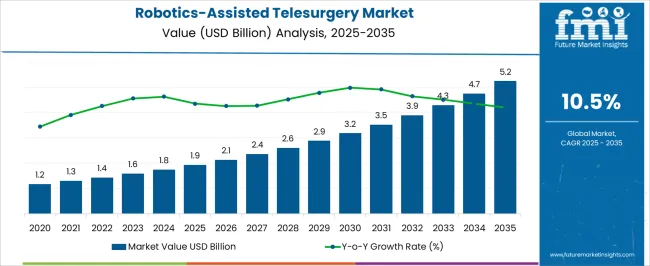
| Metric | Value |
|---|---|
| Robotics-Assisted Telesurgery Market Estimated Value in (2025 E) | USD 1.9 billion |
| Robotics-Assisted Telesurgery Market Forecast Value in (2035 F) | USD 5.2 billion |
| Forecast CAGR (2025 to 2035) | 10.5% |
The Robotics-Assisted Telesurgery market is experiencing strong growth, driven by increasing adoption of robotic surgical technologies to enhance precision, reduce invasiveness, and improve patient outcomes. Rising demand for minimally invasive procedures, coupled with technological advancements in robotic platforms and telecommunication systems, is supporting market expansion. Hospitals and specialized surgical centers are increasingly leveraging robotic-assisted systems to perform complex procedures with higher accuracy and reduced recovery times.
Integration of real-time imaging, AI-assisted navigation, and haptic feedback has enhanced operational efficiency while ensuring patient safety. Growing investments in healthcare infrastructure, along with the rising prevalence of chronic and complex surgical conditions, are further driving adoption. Additionally, regulatory approvals for robotic surgical systems and expanding reimbursement frameworks are contributing to market accessibility.
As healthcare providers prioritize precision, efficiency, and scalability, robotics-assisted telesurgery platforms are expected to become essential tools for modern surgical practices The combination of technological innovation, clinical benefits, and operational efficiency is positioning the market for sustained growth over the coming decade.
The robotics-assisted telesurgery market is segmented by component, application, and geographic regions. By component, robotics-assisted telesurgery market is divided into Robotic Surgical Systems, Instruments & Accessories, Services, Training And Consulting, Integration And Deployment, and Support And Maintenance. In terms of application, robotics-assisted telesurgery market is classified into General Surgery, Urological Surgery, Gynecological Surgery, Orthopedic Surgery, Neurosurgery, and Others. Regionally, the robotics-assisted telesurgery industry is classified into North America, Latin America, Western Europe, Eastern Europe, Balkan & Baltic Countries, Russia & Belarus, Central Asia, East Asia, South Asia & Pacific, and the Middle East & Africa.
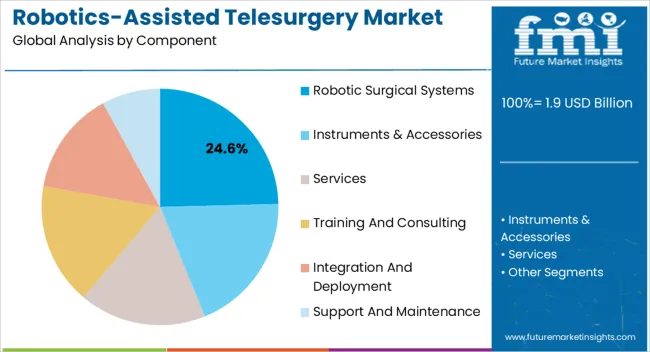
The robotic surgical systems component segment is projected to hold 24.6% of the market revenue in 2025, establishing it as the leading component type. Growth in this segment is being driven by the increasing need for advanced robotic platforms that provide precision, repeatability, and enhanced surgical control across multiple procedures. These systems integrate high-definition imaging, AI-assisted guidance, and real-time feedback mechanisms to improve surgical accuracy and reduce human error.
Scalability and adaptability for different types of surgeries, combined with reduced patient recovery times, have increased adoption among hospitals and surgical centers. Training programs and simulation capabilities offered with robotic systems are further enhancing clinical confidence and operational readiness.
Integration with telecommunication technologies allows surgeons to perform procedures remotely, expanding access to specialized care As healthcare providers continue to prioritize minimally invasive surgery, workflow efficiency, and improved clinical outcomes, robotic surgical systems are expected to maintain their market leadership, supported by ongoing technological innovation and operational advantages.
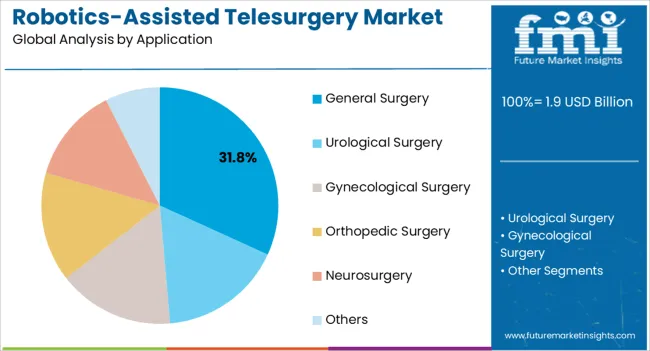
The general surgery application segment is anticipated to account for 31.8% of the market revenue in 2025, making it the leading application area. Growth is being driven by the increasing demand for minimally invasive procedures in abdominal, gastrointestinal, and other general surgical interventions. Robotics-assisted telesurgery enables surgeons to perform complex procedures with higher precision, reduced complications, and improved patient recovery times.
The integration of real-time imaging, robotic articulation, and AI-assisted navigation enhances procedural accuracy and operational efficiency. Hospitals and surgical centers are adopting these systems to improve patient outcomes, streamline workflows, and reduce post-operative complications. The ability to perform procedures remotely also addresses the shortage of specialized surgeons in certain regions, expanding access to quality care.
Rising awareness among healthcare providers, growing investments in surgical infrastructure, and favorable reimbursement frameworks further support the adoption of robotic-assisted general surgery As the need for precision, efficiency, and scalability in surgical procedures continues to increase, the general surgery application segment is expected to remain the primary growth driver of the market.
Robotics is a discipline of science that includes interface of electrical engineering, mechanical engineering and computer science technologies. It is concerned with the design, manufacturing, operation and use of the robots, along with the computer systems required to control them and process information.
This technology is slowly but surely moving from fiction to fact thanks to current research in the robotics-assisted telesurgery market.
Today, the healthcare industry has eventually reached a point where medical robots are able to ‘think’, act independently or even take critical decisions without any assistance from doctors or medical professionals.
These tele-surgery robots have already proved their mettle in assisting surgeons who perform hysterectomies or prostate cancer and other sophisticated surgeries.
Constant design improvements, and advanced medical robots has fueled the robotics-assisted telesurgery market to boom, in the years to come.
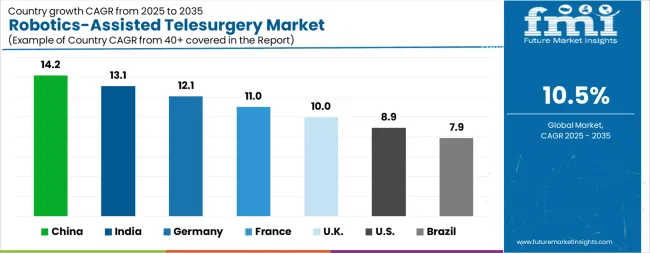
| Country | CAGR |
|---|---|
| China | 14.2% |
| India | 13.1% |
| Germany | 12.1% |
| France | 11.0% |
| UK | 10.0% |
| USA | 8.9% |
| Brazil | 7.9% |
The Robotics-Assisted Telesurgery Market is expected to register a CAGR of 10.5% during the forecast period, exhibiting varied country level momentum. China leads with the highest CAGR of 14.2%, followed by India at 13.1%. Developed markets such as Germany, France, and the UK continue to expand steadily, while the USA is likely to grow at consistent rates. Brazil posts the lowest CAGR at 7.9%, yet still underscores a broadly positive trajectory for the global Robotics-Assisted Telesurgery Market. In 2024, Germany held a dominant revenue in the Western Europe market and is expected to grow with a CAGR of 12.1%. The USA Robotics-Assisted Telesurgery Market is estimated to be valued at USD 690.3 million in 2025 and is anticipated to reach a valuation of USD 1.6 billion by 2035. Sales are projected to rise at a CAGR of 8.9% over the forecast period between 2025 and 2035. While Japan and South Korea markets are estimated to be valued at USD 88.8 million and USD 54.9 million respectively in 2025.
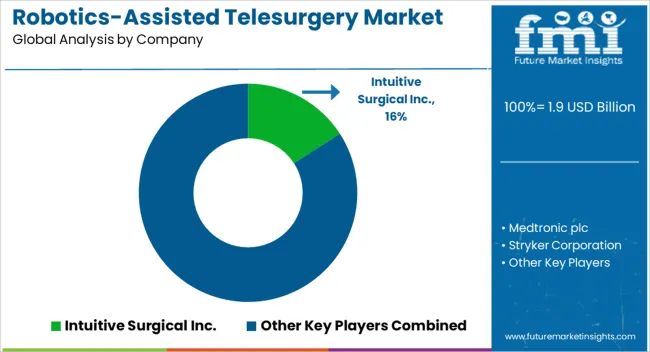
| Item | Value |
|---|---|
| Quantitative Units | USD 1.9 Billion |
| Component | Robotic Surgical Systems, Instruments & Accessories, Services, Training And Consulting, Integration And Deployment, and Support And Maintenance |
| Application | General Surgery, Urological Surgery, Gynecological Surgery, Orthopedic Surgery, Neurosurgery, and Others |
| Regions Covered | North America, Europe, Asia-Pacific, Latin America, Middle East & Africa |
| Country Covered | United States, Canada, Germany, France, United Kingdom, China, Japan, India, Brazil, South Africa |
| Key Companies Profiled | Intuitive Surgical Inc., Medtronic plc, Stryker Corporation, Johnson & Johnson, TransEnterix Inc., Zimmer Biomet Holdings Inc., Smith & Nephew plc, Mazor Robotics Ltd., Titan Medical Inc., Renishaw plc, and Aurora Surgical LLC |
The global robotics-assisted telesurgery market is estimated to be valued at USD 1.9 billion in 2025.
The market size for the robotics-assisted telesurgery market is projected to reach USD 5.2 billion by 2035.
The robotics-assisted telesurgery market is expected to grow at a 10.5% CAGR between 2025 and 2035.
The key product types in robotics-assisted telesurgery market are robotic surgical systems, instruments & accessories, services, training and consulting, integration and deployment and support and maintenance.
In terms of application, general surgery segment to command 31.8% share in the robotics-assisted telesurgery market in 2025.






Our Research Products

The "Full Research Suite" delivers actionable market intel, deep dives on markets or technologies, so clients act faster, cut risk, and unlock growth.

The Leaderboard benchmarks and ranks top vendors, classifying them as Established Leaders, Leading Challengers, or Disruptors & Challengers.

Locates where complements amplify value and substitutes erode it, forecasting net impact by horizon

We deliver granular, decision-grade intel: market sizing, 5-year forecasts, pricing, adoption, usage, revenue, and operational KPIs—plus competitor tracking, regulation, and value chains—across 60 countries broadly.

Spot the shifts before they hit your P&L. We track inflection points, adoption curves, pricing moves, and ecosystem plays to show where demand is heading, why it is changing, and what to do next across high-growth markets and disruptive tech

Real-time reads of user behavior. We track shifting priorities, perceptions of today’s and next-gen services, and provider experience, then pace how fast tech moves from trial to adoption, blending buyer, consumer, and channel inputs with social signals (#WhySwitch, #UX).

Partner with our analyst team to build a custom report designed around your business priorities. From analysing market trends to assessing competitors or crafting bespoke datasets, we tailor insights to your needs.
Supplier Intelligence
Discovery & Profiling
Capacity & Footprint
Performance & Risk
Compliance & Governance
Commercial Readiness
Who Supplies Whom
Scorecards & Shortlists
Playbooks & Docs
Category Intelligence
Definition & Scope
Demand & Use Cases
Cost Drivers
Market Structure
Supply Chain Map
Trade & Policy
Operating Norms
Deliverables
Buyer Intelligence
Account Basics
Spend & Scope
Procurement Model
Vendor Requirements
Terms & Policies
Entry Strategy
Pain Points & Triggers
Outputs
Pricing Analysis
Benchmarks
Trends
Should-Cost
Indexation
Landed Cost
Commercial Terms
Deliverables
Brand Analysis
Positioning & Value Prop
Share & Presence
Customer Evidence
Go-to-Market
Digital & Reputation
Compliance & Trust
KPIs & Gaps
Outputs
Full Research Suite comprises of:
Market outlook & trends analysis
Interviews & case studies
Strategic recommendations
Vendor profiles & capabilities analysis
5-year forecasts
8 regions and 60+ country-level data splits
Market segment data splits
12 months of continuous data updates
DELIVERED AS:
PDF EXCEL ONLINE

Thank you!
You will receive an email from our Business Development Manager. Please be sure to check your SPAM/JUNK folder too.
Chat With
MaRIA